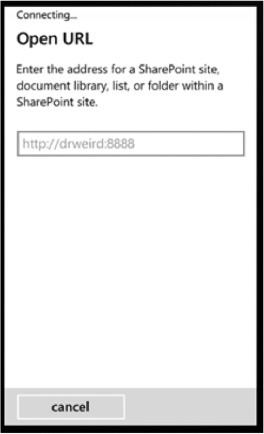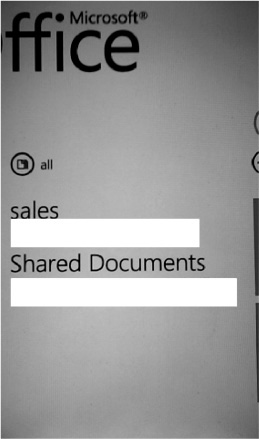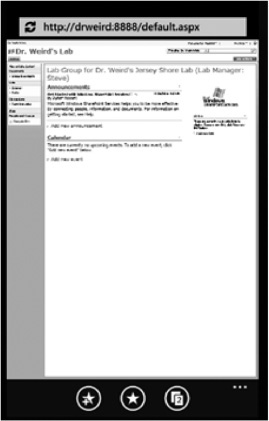Microsoft SharePoint is quickly becoming a staple of many an office worker's life. A system designed to let you share, collaborate, and get work done more easily, SharePoint seems like a logical addition to any mobile device. However, only a Windows Phone 7 device thus far lives up to the promise of SharePoint on a smartphone. In this chapter, we'll discuss how to connect to your company's SharePoint server, allowing you to access work files wherever you may be.
Note
Windows Phone 7 requires that your company be running the latest version of SharePoint Server (Microsoft SharePoint 2010), as well as a Microsoft Forefront Unified Access Gateway (UAG) server. This ensures that your phone connects securely to the SharePoint server. If your company uses an older version of SharePoint, or does not have a UAG server, you can still browse the SharePoint server in Internet Explorer on your phone; however, you cannot connect to it using the Office Hub. We'll discuss how to connect to a SharePoint server using both of these methods in this chapter.
If your company is running SharePoint Server 2010 and Forefront Unified Access Gateway (UAG), your Windows Phone can connect directly to the server and browse files. Follow these steps to get started:
Turn on and unlock your phone.
Tap the Arrow icon in the upper right to access the applications list, then tap Office (see Figure 21-1).
When the Office Hub opens, press and slide your fingers from right to left, switching panes until you see the SharePoint pane (see Figure 21-2).
Tap the open URL button.
Enter the address to your SharePoint server and press the Arrow icon in the lower right of the keyboard to navigate to it (see Figure 21-3).
At this point, your phone will attempt to connect to the SharePoint server (see Figure 21-4). If all goes well, you will successfully connect. If you have trouble, see the "Troubleshooting SharePoint Connections" section later in this chapter for some tips on how to fix the problem.
Your phone will prompt you for your SharePoint username, password, and domain (see Figure 21-5). Enter these and press done.
Once you log in, your phone will display the different pages of the SharePoint site. In Figure 21-6, you can see that we're on the Sales SharePoint site for this company, and we can navigate to Announcements, Links, Shared Documents, and more.
Assume that you've tapped the Shared Documents link and find that there is an Excel document on the server you can view (see Figure 21-7). Tapping that document will open it in Mobile Excel.
Pressing and holding on a document for a few moments brings up more options, as shown in Figure 21-8. These options include the ability to download the file (but not open it), as well as the ability to tell your phone to always keep a copy of this file offline (refreshing it whenever you connect to SharePoint). You can also send a link to the file, view its properties, or delete the copy of the file on your phone.
On any SharePoint screen, you can tap the Ellipsis button for more options (see Figure 21-9). These options include the ability to refresh the current view (so you can see any changes that have been made), bookmark the link, and open the site in your browser.
You may recall that the Office Hub has a pane to the right of the SharePoint pane, as shown in Figure 21-2. This is where bookmarks from within SharePoint servers will appear. If you tap bookmark this link (see Figure 21-9), a bookmark will be created, as shown in Figure 21-10.
You've now connected to a SharePoint site, which means you can browse and open its files, bookmark different locations, and more!
One great thing about technology is that it's always changing. This is also a problem for those of us who have to maintain it. If your company hasn't had the time, ability, or resources to upgrade to SharePoint 2010, you'll need to access your SharePoint server through a browser. Follow these steps to do so:
Turn on and unlock your phone.
Tap Internet Explorer to launch the browser (see Figure 21-11).
Enter the address of your SharePoint server in the address bar.
Note
Your company's SharePoint server must be accessible to either the Web or the wireless network your phone is connected to before you can access it on your phone.
Your phone will prompt you to enter your SharePoint username, password, and domain (see Figure 21-12).
After you enter this information, your phone will open the SharePoint site (see Figure 21-13); the site should look similar to what you see when accessing the site on your computer. You can now navigate the site as you would any other site in Internet Explorer; for example, you can even tap files to open them in Word or Excel!
Sometimes things go wrong when connecting to SharePoint. Some of these things are fixable on your end, while others will require you to contact your company's system administrator for help in resolving the problem. This section will describe some of the more common errors you may encounter, as well as how to fix them.
Sometimes you get an error indicating that SharePoint can't open or doesn't support the site you're trying to open. This error occurs when trying to connect to a SharePoint server, and it will look something like the error shown in Figure 21-14.
Here are some things you can do to attempt to fix the problem:
Check the address— This suggestion may sound simple (or even obvious), but the solution can actually be a bit more complex. While typos in the address can occur, you may also have entered
http://instead of thehttps://that your company may require. Be sure to check the entire address for errors.The SharePoint server isn't running SharePoint 2010— Earlier in this chapter, we mentioned that your company's SharePoint server must be running SharePoint 2010 for the Office Hub to be able to connect to it. If it isn't, you'll see the "Can't open" error, and you'll need to open the site in your web browser.
You don't have the correct certificate files installed— Some SharePoint servers may require that certain certificates be installed on your phone. Certificates are small key files that tell the server that your phone is allowed to connect. If you know your company is running SharePoint 2010 and you still cannot connect, ask your system administrator if you need to install any certificate files on the device in order to connect. You can install these files by emailing them to yourself (or having your admin email them to you), and then opening these files as you would any other email attachment. You might also be able to go to a special website on your phone and download the certificate files from there (again, check with your IT support person). Once you download these files to your phone, you will be prompted to install them. At this point, you can attempt to connect to the SharePoint server again.
You may also encounter the "Can't connect" error when trying to connect to a SharePoint server. It will look something like the error shown in Figure 21-15.
Here are some things you can do to attempt to fix the problem:
Do nothing, hit retry— Oddly enough, this worked quite frequently in my testing. So, before you try the following solutions, hit the retry button shown in Figure 21-15 once or twice.
Check your Internet connection— Make sure you can browse to other websites, download email, and do other things that require an Internet connection.
The SharePoint Server isn't accessible on the Internet or your wireless network— Your SharePoint server might not be available on the Internet or the wireless network you're connected to for security reasons. Try using a non-company-issued computer to connect to the server. If you still can't bring up the site, it's likely your system administrator has blocked traffic from either the Internet or non-corporate devices from accessing SharePoint. If your laptop requires you to log into a Virtual Private Network (VPN) before accessing SharePoint, then this is a good indication that the SharePoint server isn't accessible online. Windows Phone 7 currently does not support VPN connections.
I hope you're enjoying your SharePoint server connection and that you didn't even read this last section on troubleshooting! I also hope that you will find Windows Phone 7 to be a great way to stay in touch with your office while on the go!
Finally, I'd like to take a moment to thank Nuno Luz, a Microsoft MVP from www.pocketpt.net, for letting me connect to his SharePoint server. Without his help, this chapter would have been much more difficult to write!















